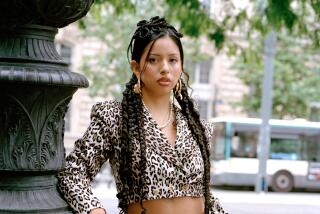âIdentitiesâ Explores Bonds of Diversity
Nine lesser-known L.A. artists of Latino descent make up the cast of âIntersecting Identitiesâ at USCâs Fisher Gallery. The frontispiece work is a full-length portrait by Salomon Huerta depicting an attractive, long-haired young woman holding a stalk of flowers and wearing an off-the-shoulder blouse with mannish pegged trousers.
Although clearly an image from the barrio here-and-now, it has the emotional deadpan and general style of the French Modernist precursor Edouard Manet. Most anyone conversant with the history of art will recall that one of the most persistent contemporary criticisms of Manetâs portraits was that he leaned a little too hard on the model set by the great Spanish master Velazquez. So here we have Huerta, a local Latin American painter consciously evoking an ancestral link to Spain. This has not been the usual pattern among Chicano artists. They have been generous about tipping their stylistic hats to Mexican folk art and the great muralists but not, quite understandably, the land of the conquistadors.
So whatâs going on? Well, according to catalog essays by gallery director Selma Holo and exhibitions curator Jennifer Jaskowiak, thereâs been a noticeable shift in attitude among latter-day Latino artists. The gist of this show--a collaborative project between the gallery and Madridâs Casa de America--is to demonstrate that such artists are not all of a single mind but individuals with divergent attitudes toward a common Spanish-speaking heritage. They are, like most Americans, a hybrid people.
Huertaâs allusion to Velazquez via Manet is sophisticated. If there is a cultural critique embedded therein, it must be directed at the French. They had an irritating habit of conscripting great Spanish artists like Picasso, Miro and Dali into the School of Paris, thus significantly co-opting the wellsprings of Surrealism.
Both the surreal and the cosmopolitan echo in the wry art of Alfredo de Batuc. Adept in more than one medium, he makes drawings and ceramics that juxtapose fish out of water with L.A. City Hall. Somehow this is perfectly apt. He makes many self-portraits dressed in a tux a la Max Beckmann. In the most startling of these you canât tell what heâs wearing. All you see is Batucâs head emerging from the loins of Frida Kahlo.
Frank Gutierrez reaches back to the Italian commedia dellâarte for the clowns and harlequins that inhabit his symbolic landscapes. His style is both vigorous and weighty. He confronts the seemingly insoluble problems of human existence. In âBell Ringer,â a busy entertainer does his thing in an empty desert. In âRidiculous Folly,â a parental clown tries to protect birdsâ eggs from danger. In such a lexicon of absurdity there is the obligatory image about how men and women just canât see one another.
You canât get a deep sounding on Joey Krebs from his single painting âBlack and White.â You can tell that his spooky expressionist style is hip to Emil Nolde and Richard Lindner. True to its thesis, âIntersecting Identitiesâ includes other kinds of artists. Four who work with the camera share a documentary attitude infused with the juices of differing personalities. Delilah Montoya manages to be both detached and soulful in studies of Latin Americans taken against graffiti-soaked backgrounds. Ricardo Valverde tries the tricky blend of combining photos with handwritten text and drawings. Occasionally he brings it off, as in âWoman Wearing Glasses and Facing Right.â Christina Fernandez introduces a touch of the Cindy Sherman-style performance artist in a series where she plays her own grandmother with slightly risible effect.
Guillermo Bert takes photography into the realm of the installation. His âMadonna, Sacred and Secularâ consists of two oversized Polaroid negatives. Reading as eerily as X-rays, one reproduces a Raphael mother and child, the other an image of an African woman with a starving baby. The negative reversal turns the white virgin black, the black mother white.
The most assertively divergent artist here is one who wishes to be known only as the L.A. Street Phantom. His wall-sized âLooking for Americaâ has the scale of a graffiti mural and the mixed-media know-how of a contemporary museum installation. A dramatic black-and-white image of a hulking figure in the barrio night takes our attention. Then we notice a little lean-to of flimsy fabrics and austere personal belongings. Among them are three facemasks made of paper bags. You get the uneasy feeling that the piece is autobiographical, that the anonymous artist has lived his workâs scenario.
* USC, Fisher Gallery, 823 Exposition Blvd.; through Feb. 9, closed Saturdays and Sundays. (213) 740-4561.
More to Read
The biggest entertainment stories
Get our big stories about Hollywood, film, television, music, arts, culture and more right in your inbox as soon as they publish.
You may occasionally receive promotional content from the Los Angeles Times.










